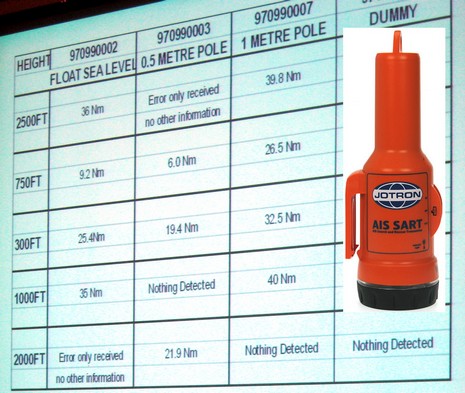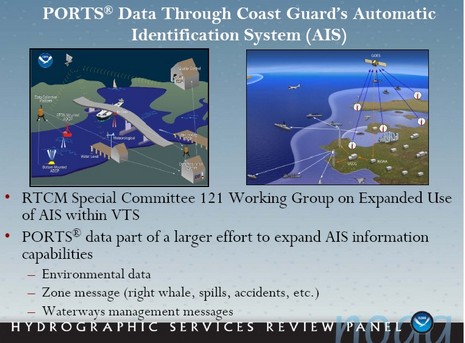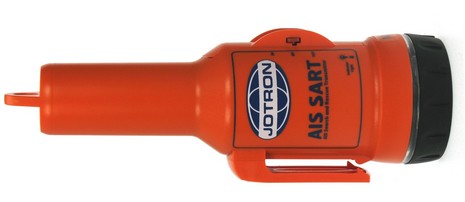AIS 2009, forward in all directions!

My coverage of the NMEA Conference last October was dominated by Class B AIS (and largely—doh!—a vessel naming issue that turned out to be immaterial). But in fact I also learned how AIS is getting into all sorts of marine systems, and was reminded of that by the recently published minutes of the Oct. 3 GMDSS Task Force meeting I attended. One item of note is the prototype AIS SART seen above, overlaid on a slide of the impressive test results such SARTs are generating. Most recreational boaters aren’t familiar with Search and Rescue Transponders, but they are standard gear on ship lifeboats, and heretofore used radar amplification—like a RACON—to help rescuers home in the last few miles. I’ve seen a live demo and wasn’t very impressed, and I’ve even heard buttoned-up GMDSS regulator types complain that it was not a very effective technology. Well, guess what? AIS SARTs work much, much better. The specifications aren’t yet wrapped up, but interestingly AIS SARTs will apparently broadcast just once a minute, but with eight message bursts to compensate for wave interference. Is there lots more AIS may do? You betcha…
How about replacing the 121 MHz homing signal send out by EPIRBS with a longer range, more accurate, and accessible-to-most-any-boat AIS signal? A committee is looking into it. Why not use AIS to broadcast local “NOAA PORTS data, weather and other security and environmental information.” Apparently it’s already being tested in Tampa, Florida (slide below, full PDF here)! Couldn’t AIS be used for the global Long Range Identification and Tracking (LRIT) system being mandated on ships? Well, maybe, and Orbcomm already has some AIS receivers in space. And while it’s not mentioned in the Task Force minutes, and while AIS Base Stations—capable of changing every transponder’s frequency and other serious stuff—will only be run by the government (understandable!), I did hear the USCG representative say that private informational AIS transmitters will be treated like Private Aids to Navigation. So, hey, your yacht club or harbor master may eventually be delivering useful nav info via AIS.
Now, it’s true that much of this involves big ships and that most of our AIS plotting devices don’t yet understand much beyond standard vessel messages, but I hope that the AIS nay-sayers—”too many targets!”… “screens too busy!”—will note that the conservative folks who actually manage this system don’t seem concerned about overburdening it. Meanwhile, my latest ode to Class B is up at PMY, along with verbiage on the Simrad AI50 (which I hope to test once I get out of NYC), the Furuno FA-50 (more impressions here), Digital Yacht’s SPL250 AIS/VHF/FM antenna splitter (more Panbo-style detail here), and Icom’s MXA-5000 AIS receiver (which I’m told is now shipping, and I’d also like to try). Plus, Navagear is on the AIS target to DSC VHF call bandwagon, a feature that’s gotta happen, right? AIS-wise, at least, 2009 is going to be a good year.














Proposed satellite AIS receivers will ignore Class B AIS transmission to avoid overload. At least that is the proposal based on simulation by the EU. The proposal goes further stating that a 3rd AIS frequency (one of the DSC CH 70 gardbands), which is allocated worldwide be used with an abbreviated message as a Class A uplink to satellites until shore-based AIS basestation transmissions are in range at which point the Class A AIS would cease transmissions intended for satellite reception.
I haven’t seen any specifications for the Orbcomm AIS receivers in order to see if they conform to the recommendations regarding ignoring Class B but they may will. Since there is no agreement on using the 3rd AIS frequency I imagine the Orbcomm satellites receive existing Class A transmissions on the existing frequencies, one of which is allocated worldwide.
Cheers and Happy New Year to all.
Richard D.
s/v RED
I had a bad experience with a SART.
I bought a SART for my sailboat back in 2006, and using the integrated test feature (go 40 yards away and push switch to test mode) did not see it on my Raymarine radar. After similiar results with a replacement unit, the vendor told me that it’s possible that new Raymarine radars are filtering it out (They had only tested with Furuno).
After four months of demanding a refund (they tried to argue that if I needed help I was better off that a Furuno (commercial) user responded rather than a Raymarine (recreational) user), I got a refund.
My original intention of using the SART (with one button press my crew can summon the coast guard), is now meet with DSC and Rescue 21 … but this AIS SART would seem useful for those of us that are outside the current Rescue 21 deployments.
As far as I know, 121 mhz ans 243 mhz are no longer supported bij GMDSS conforming EPIRBs.
It’s confusing, Michel. The old EPIRBs that used 121 MHz to send distress signals to low orbit satellites are obsolete. But all current 406 MHz EPIRBs also broadcast a low power 121 MHz homing signal. That’s because the basic 406 technology (without the GPS option) is only accurate to a mile or so, and because many SAR resources, and some yachts, are equipped to home in on 121 MHz.
As I was weaving my way through a bunch of crab pots in the San Juan Islands recently, I was wishing they all had AIS transponders on them. They would not need much power, a mile warning would be great.
Tony
Ignoring Class B will not prevent overload. It uses the same frequencies as Class A messages. The problem with Satellites is that their ‘view’ is much wider than a ship, resulting in collisions.
Regarding the confusion about 121.5 MHz, and the demise of EPIRBS using that and 243 as primary distress frequencies: The USCG has created some neat widgets to remind all of the Feb. 1 deadline:
http://www.uscg.mil/global/widget/beacon.asp
Class A uses SOTDMA whereas Class B uses CSTDMA. Basically that means that Class A, the big guys, randomly broadcast on one of the 4500 slots per minute. (GPS provides the distributed time synchronization for slotting.) Class B on the other hand *listens* first and then broadcasts (every 30s under 14 knots).
So yes, the big guys will always get through, avoiding overload for them. And the little guys will eventually get through, avoiding overload for them.
Slight correction — there are 2250 slots per minute. 2 channels. But IIRC part of the Class A algorithm says not to transmit on the other frequency if the slot is already in use. Also, Class B uses the same slots, it just waits a bit to detect use before transmitting. There is no way for a receiver to ignore one transmission type or another. It has to receive it first 🙂